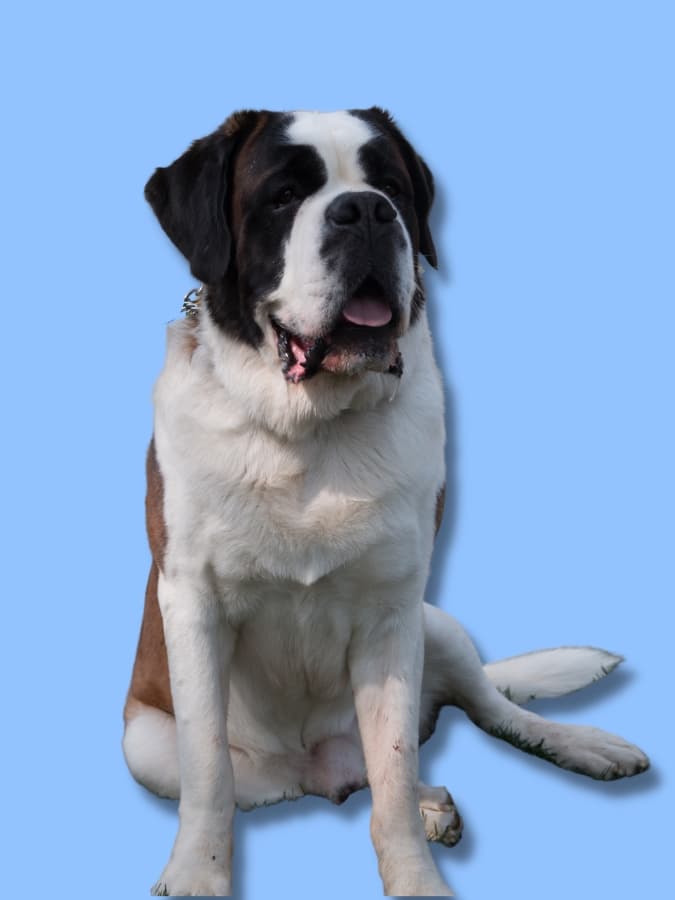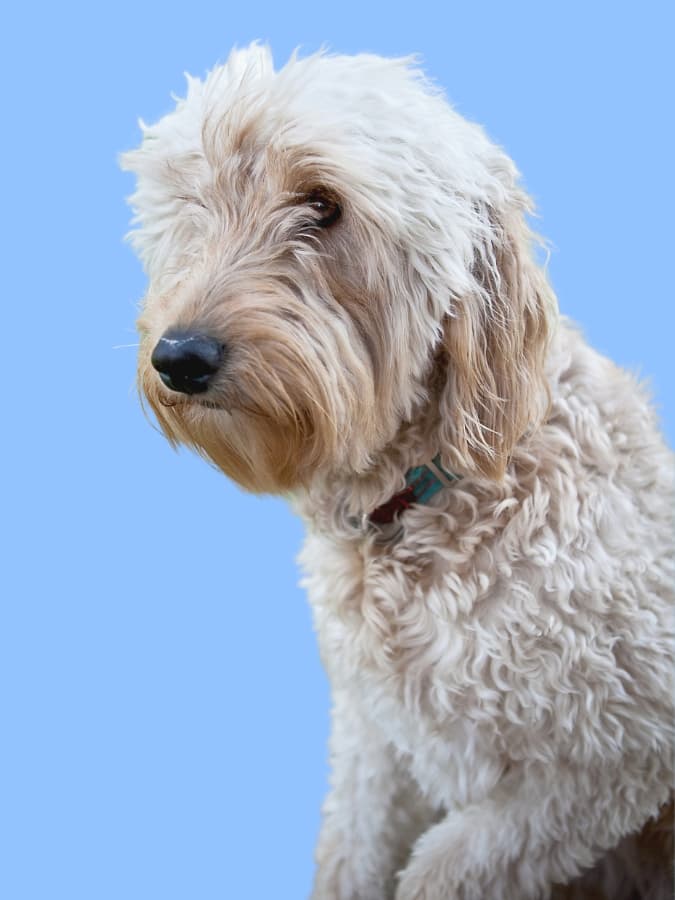Move over Labradoodles and Cockapoos, there’s a new furry friend in town: the Golden Saint Berdoodle!
This lovable new Doodle dog is a mashup of a Goldendoodle and a Saint Bernard.
As Goldendoodles continue to rise in popularity, we are starting to see new types of Doodles popping up.
Mixing a standard breed, such as the Saint Bernard, with a Goldendoodle blends the best traits and characteristics of three different dogs.
So, is the Golden Saint Berdoodle going to be the next trendy breed? Let’s find out!
What is a Golden Saint Berdoodle?
A Golden Saint Berdoodle is a rare dog that mixes a Golden Retriever, a Saint Bernard, and a Poodle. This breed is also known as a Golden Saint Berdoodle, Golden St. Berdoodle, or Golden Berdoodle.
The Golden Saint Berdoodle is a relatively new Doodle breed. I don’t think it’s very popular right now, but I wouldn’t be surprised if that changes in the future!
This breed is perfect for families with children and other pets, as they are known to be gentle and patient. They inherit a friendly and affectionate nature, intelligence, and hypoallergenic coat.
The Golden Saint Berdoodle is a large dog that can weigh more than 100 pounds and stand up to 28 inches tall.
They have thick, curly coats that can come in various colors, including black, white, brown, and gold. They are also known for their long, droopy ears and big, expressive eyes.
My Goldendoodle and St. Bernard puppy friends
Before I go into the history of St. Bernard and Goldendoodle, I wanted to relay a cute story of my experience with two puppies of these breeds.
Okay, maybe it’s not a cute story, but I remember it fondly. When I got my Doodle dog, Murphy, I lived at an apartment complex in Ohio.
I had no backyard (or front yard even) to let her out. It was always walks. With a young puppy, this meant TONS of walks.
Luckily, my apartment complex had a community dog run. It was basically a tiny, fenced-in square.
This place became my savior. It turns out two other residents had purchased puppies about the same time I bought mine.
One was an adorable St. Bernard puppy named Luna, and the other was a Goldendoodle named Henry. Luna, Henry, and Murphy all got along so well!
We would meet up daily for romps at the dog run. I loved how sweet and gentle St. Bernard and Goldendoodle pups were!
My dog would agree.
From that experience, both breeds hold a special place in my heart. I do not doubt that the St. Bernard-Goldendoodle mix would be a lovely breed!
Okay, now let’s check out the history of these two breeds!
Saint Bernard History
The Saint Bernard breed originated in the Swiss Alps in the 11th century.
The breed was specifically bred for its strength, intelligence, and ability to navigate the treacherous terrain of the Alps.
Monks at the Saint Bernard Hospice initially bred these dogs to serve as rescue dogs for lost or injured travelers in the mountains.

Throughout the centuries, Saint Bernards continued to be bred for their rescue abilities, and many were credited with saving countless lives.
In the 17th century, the breed was brought to other parts of Europe, where they were used as guard dogs and companions.
In the 1800s, Saint Bernards were brought to the United States, where they quickly gained popularity.
Today, Saint Bernards are still used as rescue dogs, but they are also beloved family pets.
They are known for their gentle, calm nature, loyalty, and devotion to their owners.
Saint Bernards are also known for their large size and thick, fluffy coats, which require regular grooming to keep them healthy and looking their best.
Oh yeah, and they often slobber a lot.
Goldendoodle History
The Goldendoodle originated in the United States in the 1990s and was created by breeding a Golden Retriever with a Poodle.

It was initially developed as a hypoallergenic guide dog for people with disabilities, and its popularity quickly grew due to its friendly and loving temperament.
The Goldendoodle comes from a family of hunters. The Poodle was bred in Germany as a waterfowl hunting dog. Golden Retrievers were also bred as waterfowl hunters in Scotland.
The breed is known for being smart, loyal, and goofy, which makes it a great choice for many families.
Physical Characteristics
The Goldendoodle-Saint Bernard mix is a large dog breed that inherits its physical characteristics from its parent breeds. Here are some of the physical characteristics of this breed:
Height
The Goldendoodle-Saint Bernard mix is a large dog breed that can grow up to 22-30 inches in height, measured from the shoulder to the paw. Males are usually taller than females.
Weight
This breed can weigh anywhere from 60-150 pounds, depending on its size and gender. Males are usually heavier than females.
Coat Type
The Goldendoodle-Saint Bernard mix has a thick, wavy coat that is soft to the touch.
Its coat is usually longer than that of a purebred Saint Bernard but shorter than that of a purebred Goldendoodle.
This breed is considered to be hypoallergenic, making it an excellent choice for people with allergies.
Coat Colors
The coat of the Goldendoodle-Saint Bernard mix can come in various colors, including:
- black
- white
- brown
- cream
- gold
- orange
- red
- wheat
- rust
- grey
Some dogs may have a combination of these colors in their coat, such as tricolor or bicolor.
Traits & Characteristics

Temperament
The Goldendoodle-Saint Bernard mix is a friendly and affectionate dog that loves to be around people.
They are loyal and protective, making them excellent watchdogs. They are also intelligent and eager to please, which makes them easy to train.
They are known for their gentle nature and make great family pets.
These dogs are social and love to be around people and other pets. They are playful and energetic, making them great companions for children.
They have a laid-back attitude, which makes them great for families who want a dog that is not too high-strung.
The Goldendoodle-Saint Bernard mix is highly adaptable. They can live in apartments or houses as long as they get enough exercise.
They are great for families with other pets, as they get along well with other animals.
Overall, the Goldendoodle-Saint Bernard mix is an excellent choice for families who want a friendly, loyal, and easy-to-train pup.
Health Concerns
Like all dogs, the Goldendoodle-Saint Bernard mix is susceptible to specific health issues.
However, it is less likely to suffer from breed-specific health problems since it is a mixed breed.
Some of the health concerns that may affect this breed include:
• Joint problems – such as hip and elbow dysplasia
• Eye problems – such as cataracts and progressive retinal atrophy
• Heart problems – such as dilated cardiomyopathy
• Ear problems – infections due to the floppy ears inherited from the Saint Bernard parent
Not all Goldendoodle-Saint Bernard mixes will develop these health issues, and many can be prevented or treated with proper care and attention.
Regular veterinary check-ups, a healthy diet, and exercise, can help keep your dog healthy and happy.
Lifespan
The Goldendoodle-Saint Bernard mix has a lifespan of around 10 to 12 years.
This is an average lifespan for a dog of this size.
However, it is essential to note that the lifespan of any dog can be affected by various factors, including genetics, diet, exercise, and overall health.
Pin it!
Save this big golden ball of fluff on your favorite Pinterest board.



